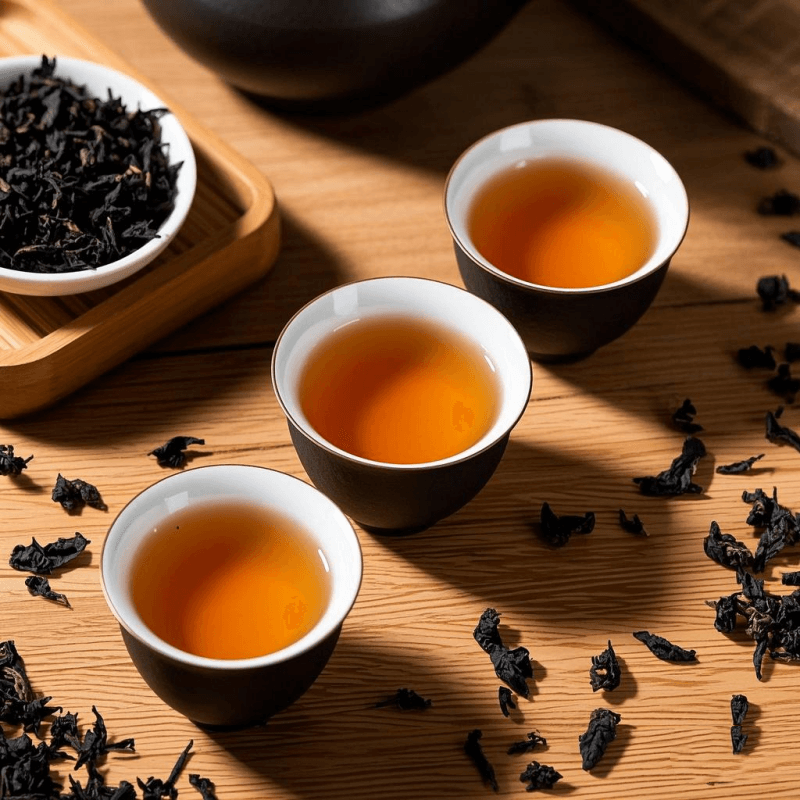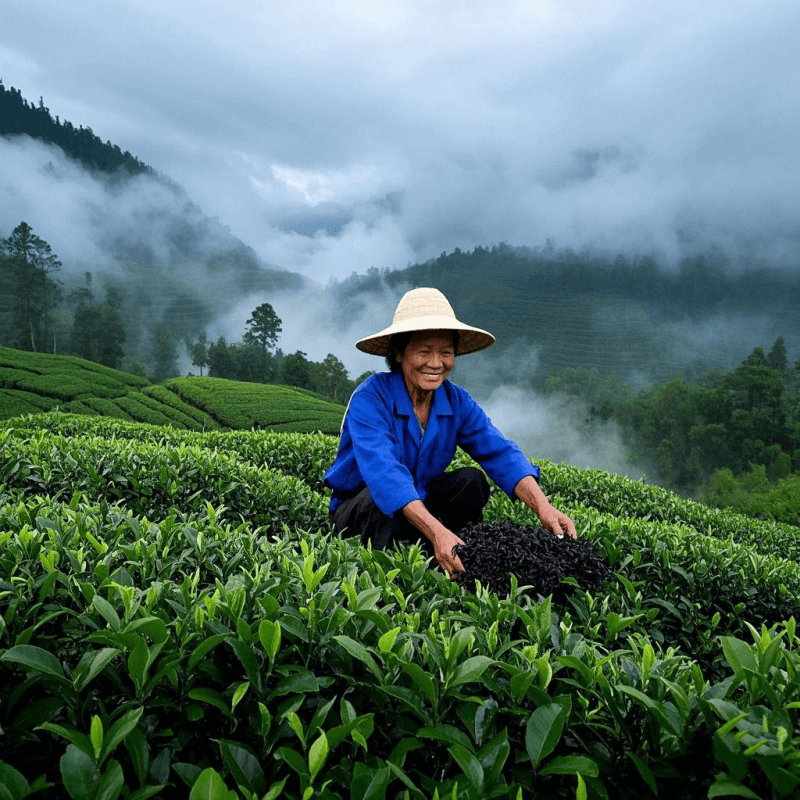Tea lovers worldwide are constantly seeking varieties that offer something extraordinary—a flavor, aroma, or experience that stands out from the crowd. Among the vast landscape of teas, black oolong tea has emerged as a beloved choice for its distinctive character. But what makes black oolong tea unique? In this guide, we’ll dive into its origins, flavor, craftsmanship, and benefits to uncover why this dark variety captivates the senses and stands apart from other teas.

Introduction: Why Explore What Makes Black Oolong Tea Unique
With so many tea options available—from delicate green teas to robust black teas—it’s natural to wonder what sets certain varieties apart. Black oolong tea, often overlooked in favor of its lighter or darker counterparts, holds a special place in the tea world. Unlike traditional green varieties with grassy notes or black teas with bold astringency, this tea balances depth and complexity in a way that’s truly one-of-a-kind. Exploring what makes black oolong tea unique reveals not just a beverage, but a story of craftsmanship, tradition, and sensory artistry. Whether you’re a seasoned tea enthusiast or new to this category, understanding its uniqueness will transform how you savor every sip.
What Is Black Oolong Tea and How It Differs from Other Oolong Types
To appreciate black oolong tea, we first need to situate it within the broader category of partially oxidized teas. These teas, defined by their partial oxidation, sit between unoxidized green teas and fully oxidized black teas, allowing for a wide spectrum of flavors. Most varieties in this category fall between 10–70% oxidation, but black oolong tea pushes this boundary—typically ranging from 60–80% oxidation, with some varieties edging closer to 90%. This higher oxidation level is what gives it the “black” moniker, though it’s still technically part of the partially oxidized family.
What makes black oolong tea unique from other types in this category? Let’s compare:
- Light varieties (e.g., pouchong): 8–20% oxidation, bright, floral, and fresh.
- Medium types (e.g., Tieguanyin): 25–50% oxidation, creamy, with fruit or honey notes.
- Black oolong tea: 60–80% oxidation, rich, toasty, and deeply aromatic, with hints of caramel, chocolate, or roasted nuts.
This higher oxidation gives black oolong tea a bolder profile than lighter types while retaining the smoothness that distinguishes it from fully oxidized black teas. It’s this middle ground that makes it a favorite for those who want complexity without the sharpness of black tea.
The Distinctive Flavor Profile of Black Oolong Tea
One of the most compelling answers to “what makes black oolong tea unique” lies in its flavor. Unlike lighter varieties that prioritize freshness, or black teas that lean into tannins, black oolong tea offers a layered, multidimensional experience that evolves with each sip.
- Aroma: Dry leaves emit warm notes of roasted chestnut, caramel, or dark honey, with a hint of earthiness. When brewed, the aroma deepens into toasted grains or dried fruit, inviting you to savor before even taking a sip.
- Taste: On the palate, it starts with a rich, malty sweetness, followed by subtle roasted undertones. Unlike some black teas, there’s little to no astringency—instead, it offers a velvety smoothness that coats the mouth.
- Finish: A lingering sweetness with hints of dried fruit or dark chocolate, making each cup satisfying yet not overwhelming.
This balance of richness and smoothness is rare. As tea expert James Norwood Pratt notes, “Black oolong tea walks the line between comfort and complexity, making it suitable for both casual drinking and contemplative sipping.” For those who enjoy bold flavors without bitterness, this profile is unmatched.
Discover the rare flavor profile of black oolong tea in our curated collection to experience these notes firsthand—each variety highlights a unique facet of its distinctive taste.
How Black Oolong Tea Is Crafted: Oxidation and Roasting Explained
The uniqueness of black oolong tea begins in its crafting. While all partially oxidized teas undergo partial oxidation, black oolong’s process is fine-tuned to achieve its deep flavor. Here’s how it’s done:
- Harvesting: Leaves are picked when mature (typically 3–4 leaves per shoot) to ensure they can withstand extended oxidation and roasting.
- Withering: Fresh leaves are spread out to dry, reducing moisture and making them pliable for processing.
- Oxidation: This is where black oolong tea diverges from lighter varieties. Leaves are gently rolled to break cell walls, then left to oxidize in controlled humidity and temperature (around 20–25°C). Oxidation continues until 60–80% of the leaf turns brown, developing rich flavor compounds.
- Roasting: After oxidation, leaves are roasted at low temperatures (120–180°C) for extended periods. This step caramelizes natural sugars, deepens color, and adds roasted notes while neutralizing any remaining astringency.
According to a study on tea processing, this combination of high oxidation and careful roasting creates unique polyphenol profiles that contribute to both flavor and health benefits (learn more about oxidation chemistry here).
Elevate your tea moments with black oolong leaves from heritage farms—these artisanal producers master the oxidation-roasting balance that makes each batch exceptional.
Health Benefits of Black Oolong Tea You Should Know
Beyond its flavor, black oolong tea offers a range of health benefits that add to its uniqueness. While research on these teas’ benefits is ongoing, studies highlight several key advantages:
- Metabolic Support: Like other varieties in this category, black oolong contains catechins and caffeine that may boost metabolism. A study published in the American Journal of Clinical Nutrition found that consumption could increase calorie burn by up to 10% over 24 hours, aiding in weight management (source).
- Antioxidant Content: Its high oxidation doesn’t diminish its antioxidant power. Black oolong tea is rich in theaflavins and thearubigins—antioxidants linked to reduced inflammation and heart health support.
- Gentle Energy Boost: With moderate caffeine (30–50mg per cup, less than coffee), it provides sustained energy without the jitters, making it ideal for afternoon sipping.
- Digestive Comfort: The smooth, low-astringency profile makes it easier on the stomach than some black teas, while its natural compounds may support gut health.
These benefits, paired with its delicious flavor, make black oolong tea a practical choice for those prioritizing wellness without sacrificing taste.
How to Brew and Enjoy Black Oolong Tea at Its Best

To fully appreciate what makes black oolong tea unique, proper brewing is essential. Its robust leaves stand up to hotter water and longer steeps than lighter varieties, allowing their complex flavors to fully develop.
Brewing Steps:
- Water Temperature: Heat water to 195–205°F (90–96°C)—hot enough to extract rich flavors without scorching the leaves.
- Leaf-to-Water Ratio: Use 1–2 teaspoons of black oolong tea per 6 ounces (180ml) of water.
- Steeping Time: Start with 3–4 minutes for the first infusion. Unlike lighter teas, black oolong can be re-steeped 4–5 times, with each steep adding 30 seconds to a minute. Later infusions often reveal sweeter, more subtle notes.
- Vessel Choice: A clay teapot (like Yixing) or ceramic infuser works best, as these materials retain heat and enhance flavor.
Learn how black oolong tea is traditionally brewed for deeper taste—traditional methods prioritize slow, intentional steeping to unlock its full potential.
Enjoyment Tips:
- Time of Day: Perfect for mornings (with breakfast) or afternoons (paired with nuts, dark chocolate, or pastries).
- Iced Option: Brew a strong batch, chill, and serve over ice for a refreshing summer drink with natural sweetness.
- Sipping Ritual: Take small sips to appreciate the evolving flavors—notice how the initial richness softens into sweetness as you drink.
Conclusion: Embrace the Uniqueness of Black Oolong in Every Sip
After exploring its flavor, craftsmanship, and benefits, it’s clear what makes black oolong tea unique: it’s a masterclass in balance. It combines the depth of black tea with the smoothness of these partially oxidized varieties, offering a flavor profile that’s both comforting and complex. Its careful crafting—through precise oxidation and roasting—creates a tea that stands out in a crowded market, appealing to both casual drinkers and connoisseurs.
Whether you’re drawn to its rich aroma, metabolic benefits, or versatile brewing options, black oolong tea invites you to slow down and savor. Explore our premium black oolong varieties for a sensory adventure and discover why this unique tea deserves a place in your daily ritual.
In a world of ordinary teas, black oolong tea shines as something extraordinary—proof that the best things in life come from balancing tradition, craftsmanship, and a little bit of boldness.
